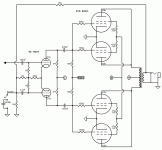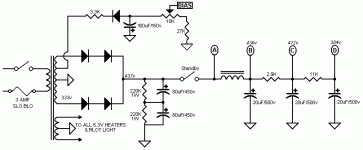got the idea of a REALLY basic and simple design for a high power amp. I have just started to play my bass guitar (bought it probably 2 years ago), and now I need an amplifier for it. I have already built a preamp with an EF86 and a BUF634 as output buffer to drive headphones etc. I havent measuered output voltage yet but i will do that eventually. the buf634 is supplied with +-15VDC so in theory i can get almost 24V P-P maximum signal voltage from my preamp. I thought I could build a power amp with just 4 tubes (probably 6l56gc or 6550) and a custom input transforer to provide phase splitting as well as gain to get the tubes near or maybe even over clip. I now i will probably get a lot of crossover distorsion but i don't think it will be that critical considering the application. am i missing something or can it really be this simple? i have never built push-pull before and I am a bit curious. I plan to use the hammond 1650R or 1650T to give me somewhere 100-120W. any other suggestions for transformers or tubes? i am open to suggestions.
Mikael,
If I were doing it, it would probably be something along the lines of the following schematic, although I would use 6BG6GAs, the 35 watt ones, rather than those expensive 6L6GCs. I would use a 12AT7 as the schematic shows. Of course you can adjust the feedback, etc. to suit yourself. As for the power supply, I would aim for a B+ of 450 volts and a bias supply of about 60 volts for plenty of adjustment range. I would also configure the bias adjustment pot such that if the wiper ever went open the output valves would receive the full bias potential rather than no bias at all.
Crossover distortion is a Class B artifact that results when one valve switches off before the other one switches on, and should be a non issue in an AB amplifier.
One small issue to consider is that of output transformer primary impedance. My recommendation would be about 2500 to 3000 ohms p to p for a quad of 6L6 family valves but Hammond does not offer one in your power range. However, matching plate impedance to output transformer primary is not really as critical as one might think, and as long as you are fairly close it should work just fine. I can't make a recommendation as to whether you would prefer the sound of the 1650R or the 1650T.
Just my opinions and hope it is helpful.
Best, Wade
If I were doing it, it would probably be something along the lines of the following schematic, although I would use 6BG6GAs, the 35 watt ones, rather than those expensive 6L6GCs. I would use a 12AT7 as the schematic shows. Of course you can adjust the feedback, etc. to suit yourself. As for the power supply, I would aim for a B+ of 450 volts and a bias supply of about 60 volts for plenty of adjustment range. I would also configure the bias adjustment pot such that if the wiper ever went open the output valves would receive the full bias potential rather than no bias at all.
Crossover distortion is a Class B artifact that results when one valve switches off before the other one switches on, and should be a non issue in an AB amplifier.
One small issue to consider is that of output transformer primary impedance. My recommendation would be about 2500 to 3000 ohms p to p for a quad of 6L6 family valves but Hammond does not offer one in your power range. However, matching plate impedance to output transformer primary is not really as critical as one might think, and as long as you are fairly close it should work just fine. I can't make a recommendation as to whether you would prefer the sound of the 1650R or the 1650T.
Just my opinions and hope it is helpful.
Best, Wade
Attachments
Try running Edcors at 5K:16 into 8 ohm speakers. Or if you only need 60W or so, do the same thing with the 6K6:16 one.
http://edcorusa.com/products/transformers/cxpp/index.html
http://edcorusa.com/products/transformers/cxpp/index.html
thank you very much (both of you) for great input. the power stage is exactly what i was looking for, but i was thinking about losing the initial gain stage completely and replace it all with a phase splitting transformer to make it even more simple. would that work?
tubewade said:Mikael,
If I were doing it, it would probably be something along the lines of the following schematic, although I would use 6BG6GAs, the 35 watt ones, rather than those expensive 6L6GCs. I would use a 12AT7 as the schematic shows. Of course you can adjust the feedback, etc. to suit yourself. As for the power supply, I would aim for a B+ of 450 volts and a bias supply of about 60 volts for plenty of adjustment range. I would also configure the bias adjustment pot such that if the wiper ever went open the output valves would receive the full bias potential rather than no bias at all.
Crossover distortion is a Class B artifact that results when one valve switches off before the other one switches on, and should be a non issue in an AB amplifier.
One small issue to consider is that of output transformer primary impedance. My recommendation would be about 2500 to 3000 ohms p to p for a quad of 6L6 family valves but Hammond does not offer one in your power range. However, matching plate impedance to output transformer primary is not really as critical as one might think, and as long as you are fairly close it should work just fine. I can't make a recommendation as to whether you would prefer the sound of the 1650R or the 1650T.
Just my opinions and hope it is helpful.
Best, Wade
great! then all i have to do is figure out what tubes to use, calculate the gain and impedance and all for the phase splitting transformer, and choose an output transformer and I'm on my way!  can't wait. I took a look at the suggested 6BG6GAs and although they are cheaper than the 6L6GC, they are not as widely available.
can't wait. I took a look at the suggested 6BG6GAs and although they are cheaper than the 6L6GC, they are not as widely available.
Sounds like your plan will work. You need to find out for sure how much output swing you have from the preamp buffer. I expect the bias voltage on the output valves to be around -50 volts, so you will need a total swing in excess of 100 volts. This you will need to know when calculating the required turns ratio of the input transformer.
Do you have a feedback scheme in mind? You would not necessarily have to use feedback but the output impedance will be rather high (probably 70 ohms or higher) using tetrodes with no feedback. Of course, you might prefer the sound that way.
Do you have a feedback scheme in mind? You would not necessarily have to use feedback but the output impedance will be rather high (probably 70 ohms or higher) using tetrodes with no feedback. Of course, you might prefer the sound that way.
Mikael Abdellah said:great! then all i have to do is figure out what tubes to use, calculate the gain and impedance and all for the phase splitting transformer, and choose an output transformer and I'm on my way!can't wait. I took a look at the suggested 6BG6GAs and although they are cheaper than the 6L6GC, they are not as widely available.
Mikael,
Be sure to check the specs on the phase splitting trafo you plan to use. Some, designed primarily as input trafos can't handle the signal level you will get from your input stage (or preamp in your case). If the trafos can handle a couple watts they should work.
I will most likely order a custom phase splitter from sowter. I suspect I will need close to 100V p-p signal wich by any standards is a LOT. Hmm.. about the feedback... haven't given it much thought. The last amp I built had no feddback and I liked it. What would i gain soundwise with feedback?
Feedback may provide no benefit in your application. The chief reason for using it in an instrument amplifier would be to reduce output impedance, but that does not mean it will sound better to you. If you have experimented with this before and found that you liked the sound with no feedback, then that is the way I would go.
In a hi-fi amp the reasons for feedback are more pronounced as feedback also increases the bandwidth of the amplifier and reduces low order harmonic distortions, but it can increase higher order distortions and especially increases odd order distortions when the amplifier is driven past clipping. Negative feedback can be a very good thing when used wisely, but is not a cure-all.
In a hi-fi amp the reasons for feedback are more pronounced as feedback also increases the bandwidth of the amplifier and reduces low order harmonic distortions, but it can increase higher order distortions and especially increases odd order distortions when the amplifier is driven past clipping. Negative feedback can be a very good thing when used wisely, but is not a cure-all.
- Status
- This old topic is closed. If you want to reopen this topic, contact a moderator using the "Report Post" button.
- Home
- Amplifiers
- Tubes / Valves
- crude, simple and powerful PP-amplifier

